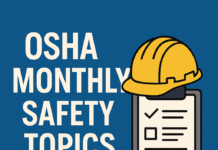
List of OSHA Standards for Safety
Introduction to OSHA Standards
What is OSHA? The Occupational Safety and Health Administration (OSHA) is a federal agency in the United States responsible for ensuring safe and healthy working conditions for employees. OSHA sets and enforces standards to protect workers across various industries.
Importance of OSHA Standards OSHA standards play a crucial role in safeguarding workers from workplace hazards, reducing injuries, illnesses, and fatalities. Compliance with OSHA regulations not only protects employees but also benefits employers by improving productivity and reducing costs associated with accidents.
General Industry Standards
Hazard Communication OSHA’s Hazard Communication Standard (HCS) requires employers to provide information and training to employees about hazardous chemicals in the workplace. This includes labels on containers, safety data sheets (SDS), and employee training programs.
Respiratory Protection OSHA’s Respiratory Protection Standard outlines requirements for the proper use of respirators in the workplace where employees are exposed to respiratory hazards. It includes procedures for selecting, fitting, and maintaining respirators, as well as training employees on their use.
Fall Protection Fall protection is crucial in preventing injuries and fatalities in workplaces where employees are exposed to fall hazards. OSHA’s Fall Protection Standard mandates employers to implement fall protection systems such as guardrails, safety nets, or personal fall arrest systems.
Electrical Standards OSHA’s Electrical Standards address electrical safety in the workplace, including wiring methods, equipment, and hazardous locations. It covers measures to prevent electric shock, electrocution, and other electrical hazards.
Construction Industry Standards
Scaffolding OSHA’s Scaffolding Standard sets forth requirements for the construction, inspection, and use of scaffolds in construction workplaces. It includes guidelines for scaffold design, assembly, and load capacity to ensure worker safety at elevated heights.
Excavations Excavation work poses significant risks to workers due to cave-ins and other hazards. OSHA’s Excavation Standard outlines safety measures for excavation and trenching operations, including protective systems, inspections, and employee training.
Personal Protective Equipment Personal Protective Equipment (PPE) is essential for protecting construction workers from various hazards. OSHA’s PPE standards require employers to provide and ensure the proper use of PPE, including helmets, gloves, eye protection, and safety footwear.
Ladder Safety Ladders are commonly used in construction activities, but improper use can lead to serious injuries. OSHA’s Ladder Safety Standard provides guidelines for the safe use, inspection, and maintenance of ladders to prevent falls and accidents.
Healthcare Industry Standards
Bloodborne Pathogens Healthcare workers are at risk of exposure to bloodborne pathogens such as HIV, hepatitis B, and hepatitis C. OSHA’s Bloodborne Pathogens Standard mandates employers to implement measures to protect employees from exposure through proper training, engineering controls, and use of personal protective equipment.
Workplace Violence Workplace violence is a significant concern in healthcare settings. OSHA’s guidelines on Workplace Violence Prevention in Healthcare and Social Assistance provide strategies for identifying and mitigating risks, including employee training, security measures, and incident reporting procedures.
Ergonomics Healthcare workers often face ergonomic hazards due to patient lifting, repetitive tasks, and awkward postures. OSHA’s Ergonomics Guidelines aim to prevent musculoskeletal disorders by promoting ergonomic practices, equipment, and workplace design modifications.
Hazardous Drugs Handling hazardous drugs in healthcare settings can expose workers to health risks. OSHA’s guidelines on Hazardous Drugs in Healthcare Settings outline procedures for safe handling, administration, and disposal of hazardous medications to minimize exposure and protect workers’ health.
Here's a list of some key Occupational Safety and Health Administration (OSHA) standards for safety:- General Industry Standards (29 CFR 1910):
- Hazard Communication Standard
- Control of Hazardous Energy (Lockout/Tagout)
- Machine Guarding
- Respiratory Protection
- Personal Protective Equipment (PPE)
- Walking-Working Surfaces
- Electrical Safety
- Bloodborne Pathogens
- Construction Industry Standards (29 CFR 1926):
- Fall Protection
- Scaffolding
- Excavations
- Electrical Wiring Methods
- Cranes and Derricks
- Personal Protective and Life Saving Equipment
- Healthcare Industry Standards:
- Bloodborne Pathogens
- Ergonomics
- Tuberculosis
- Agriculture Industry Standards:
- Respiratory Protection
- Grain Handling Facilities
- Maritime Industry Standards:
- Shipyard Employment
- Marine Terminals
- Oil and Gas Industry Standards:
- Process Safety Management of Highly Hazardous Chemicals
- Hazardous Waste Operations and Emergency Response
- Emergency Preparedness and Response Standards:
- Emergency Action Plans
- Fire Prevention Plans
Remember, this is not an exhaustive list, and specific industries may have additional OSHA standards and regulations they need to adhere to based on the nature of their work. Always refer to the latest OSHA standards and regulations for comprehensive information.Conclusion
In conclusion, OSHA standards play a vital role in ensuring workplace safety across various industries, including general, construction, and healthcare. Compliance with OSHA regulations is essential for protecting workers from hazards and promoting a healthy work environment.
HSE Training Requirements in OSHA Standards
OSHA Certification Online Free
How to Get OSHA 510 Certification
FAQs
- What is the purpose of OSHA standards? OSHA standards aim to ensure safe and healthy working conditions by setting and enforcing regulations to protect workers from hazards.
- How often are OSHA standards updated? OSHA standards are periodically reviewed and updated to address emerging workplace hazards and advancements in safety practices.
- Are OSHA standards mandatory? Yes, OSHA standards are legally enforceable and must be followed by employers to ensure workplace safety and compliance with regulations.
- What happens if a company violates OSHA standards? Companies that violate OSHA standards may face penalties, fines, and enforcement actions, depending on the severity of the violation and its impact on worker safety.
- Where can I find more information about OSHA standards? More information about OSHA standards and regulations can be found on the official OSHA website or through local OSHA offices and resources.
























